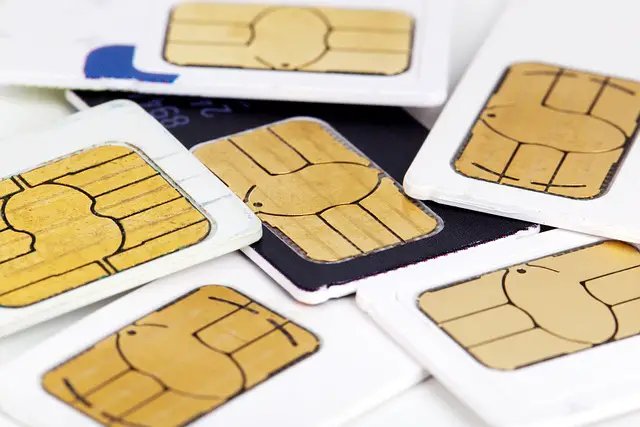A prepaid SIM card requires you to pay in advance for usage and services, whereas a postpaid SIM card requires you to pay for the services you used at the end of a billing cycle. With a prepaid SIM, you have control over how much you spend, while a postpaid SIM usually involves a fixed monthly bill and may include a minimum term contract.
What is a prepaid sim card?
(Image by PublicDomainPictures from Pixabay )

A prepaid SIM card is a type of SIM card that allows you to pay for your mobile service in advance. This means that you can top up your account with credit before you make any calls, texts or use data.
Prepaid SIM cards are often used by people who don’t want to be tied into a contract, or by those who want to control their spending on mobile services. They can be a good option if you only need occasional use of a mobile phone, or if you’re travelling overseas and want to avoid roaming charges.
To use a prepaid SIM card, you will need to purchase a top-up voucher from a store or online. Once you have topped up your account, you can start using your phone as normal. Your credit will be used for any calls, texts or data you use until it runs out. When your credit is low, you can simply top up again to continue using your phone.
What is a postpaid sim card?
A postpaid sim card is a type of sim card that allows you to pay for your mobile service after you have used it. This means that you will receive a bill at the end of each month for the previous month’s usage. Postpaid sim cards are typically more expensive than prepaid sim cards, but they offer a few advantages. For example, postpaid sim cards usually come with larger data allowances and more flexible payment options.
The benefits of a prepaid sim card
Prepaid sim cards offer many benefits over postpaid sim cards. Perhaps the most obvious benefit is that you can pay for your service in advance, which means you never have to worry about running up a large bill. Prepaid sim cards also tend to be much cheaper than postpaid sim cards, so if you’re on a tight budget, they’re a great option.
Another great benefit of prepaid sim cards is that they’re much easier to keep track of your usage. With a postpaid sim card, you might not realize how much data or minutes you’ve used until it’s too late and your bill arrives. With a prepaid sim card, you always know exactly how much you have left, so you can avoid overage charges.
Finally, prepaid sim cards are great for international travelers. If you’re going to be traveling abroad, it’s often much cheaper and easier to buy a local prepaid sim card rather than using your regular phone plan. This way, you’ll have a local number and won’t have to worry about expensive roaming charges.
The benefits of a postpaid sim card
A postpaid sim card has many benefits, including the ability to build credit, get a lower monthly bill, and receive customer service support.
Prepaid sim cards are great for those who want the flexibility of not being tied to a contract, but there are some drawbacks. Postpaid sim cards have many benefits that make them worth considering.
For starters, postpaid sim cards can help you build credit. If you make your payments on time and keep your account in good standing, you can improve your credit score. This can be helpful if you ever need to take out a loan or apply for a mortgage.
Another benefit of a postpaid sim card is that you may be able to get a lower monthly bill. This is because service providers often offer discounts and other incentives to customers who sign up for a postpaid plan. In addition, postpaid customers typically have access to better customer service support than prepaid customers.
Which one is better for you?
(Photo by Jonas Leupe on Unsplash )

Prepaid SIM cards are a great option if you want to have complete control over your spending. With a prepaid SIM, you can top up your account with as much or as little money as you want, and you’ll only be charged for the calls, texts, and data that you use. This makes it easy to budget for your mobile usage.
Postpaid SIM cards are a good choice if you want the convenience of not having to top up your account all the time. With a postpaid SIM, you’ll be billed at the end of each month for the calls, texts, and data that you’ve used. This can be a more flexible option if you don’t want to worry about topping up your account regularly.
How to choose the right prepaid or postpaid sim card
When you’re ready to purchase a mobile phone plan, you’ll need to decide whether to go with a prepaid or postpaid SIM card. Both have their own advantages and disadvantages, so it’s important to choose the option that best suits your needs.
Prepaid SIM cards are a great option for those who want complete control over their spending. With a prepaid plan, you load money onto your SIM card in advance, and then use that credit to pay for your calls, texts, and data usage. This means that you’ll never spend more than you have loaded onto your card, making it easy to stick to a budget.
Postpaid SIM cards are best suited for those who want the convenience of not having to worry about topping up their credit in advance. With a postpaid plan, your service provider will bill you at the end of each month for your usage. This can be helpful if you don’t want the hassle of keeping track of your credit balance, but it does mean that you could end up spending more than you intended if you use more data than expected.
So, which option is right for you? If you’re not sure, here are a few things to consider:
What happens if postpaid SIM is not paid?
If you have a postpaid SIM card and do not pay your bill, your service will be cut off. This means that you will no longer be able to make or receive calls, texts, or use data. Your account will also accrue late fees and you may be subject to collection proceedings.
Why do companies prefer postpaid?
Companies may prefer postpaid SIM cards because they usually involve a fixed monthly bill and may include benefits such as discounted rates, priority customer service, and better service quality. Postpaid plans also offer more convenience since users don’t have to worry about running out of credit and can typically track their usage through online portals or mobile apps. Additionally, postpaid plans may provide greater flexibility for business users who require higher usage limits and may be eligible for corporate discounts.
What are the 3 types of SIM cards?
There are three types of SIM cards:
Mini–SIM: This is the most common type of SIM card, also known as a “standard” SIM card. It measures 25mm x 15mm and is used in older smartphones and some feature phones.
Micro–SIM: This is a smaller SIM card that measures 15mm x 12mm. It is commonly used in mid-range and older smartphones.
Nano–SIM: This is the smallest type of SIM card, measuring 12.3mm x 8.8mm. It is used in most newer smartphones and is the standard for most mobile carriers today.
There is also a fourth type of SIM card called an eSIM, which is an embedded SIM that is built into the phone’s hardware and can be programmed by the carrier remotely.
How to convert postpaid to prepaid?
There are a few key steps to take when converting from postpaid to prepaid:
- Check with your current carrier if they offer prepaid service. If not, you’ll need to research and find a new carrier that does offer this type of service.
- Gather all the required documentation for activating a new prepaid account. This may include ID, proof of address, and a credit check.
- Call your current carrier to cancel your postpaid service, and set up a final bill payment date.
- Activate your new prepaid account with your chosen carrier. This will involve adding funds to your account ahead of time, which will then be used to pay for your phone service as you use it.
- Once your new account is active, port your old phone number over to the new carrier so you don’t have to give out a new one to everyone you know!
Do postpaid sims and prepaid sims have the same features?
Prepaid SIMs and postpaid SIMs offer many of the same features, but there are some key differences between the two that users should be aware of.
For starters, prepaid SIMs do not require a credit check or deposit like postpaid SIMs do. This means that anyone can get a prepaid SIM, regardless of their credit history. Prepaid SIMs also tend to be more flexible in terms of pricing and data plans, as users can choose from a wide range of options to suit their needs.
Postpaid SIMs, on the other hand, typically offer more data and minutes than prepaid SIMs, making them ideal for heavy users. Postpaid SIMs also come with added perks like free international calls and roaming, which can be perfect for frequent travelers. However, keep in mind that postpaid SIMs will require a credit check and deposit before you can activate them.
Featured Image By – Photo by Gilles Lambert on Unsplash








